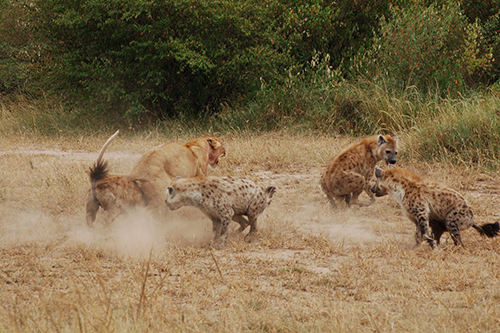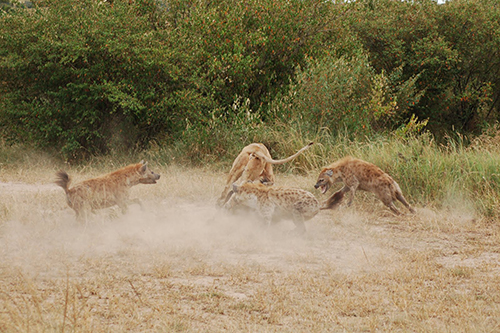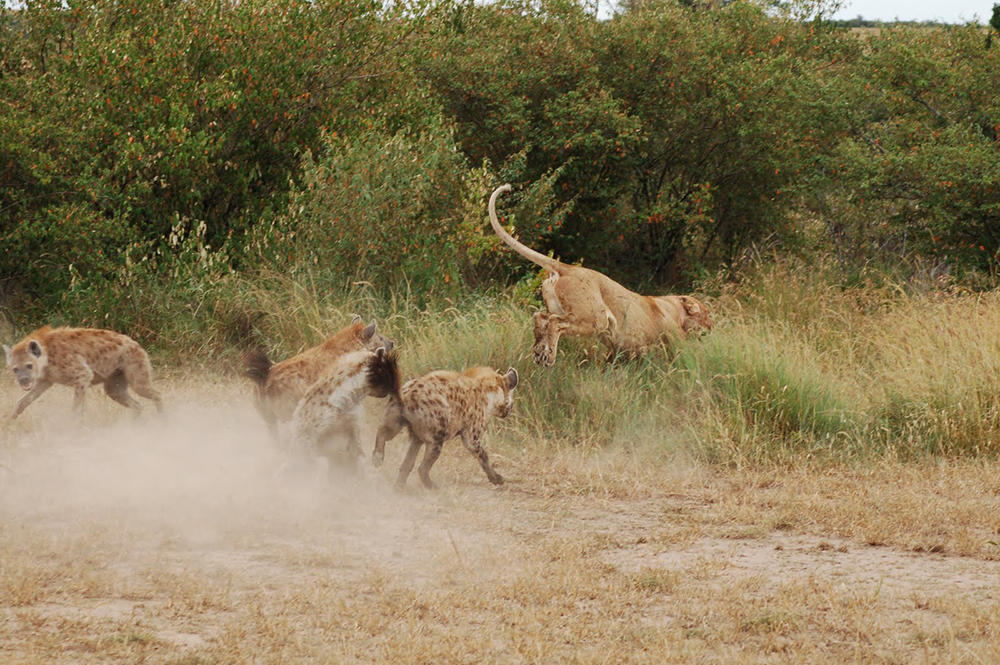‘Friendly’ hyenas are more likely to form mobs
Article Highlights
- Publishing in the journal Proceedings of the Royal Society B, a team led by Michigan State University researchers revealed that relationships and social interactions between hyenas can influence when two or more of them work together to attack lions. This cooperative behavior is called mobbing.
- Studies like these help researchers better understand how cooperation evolved not just in wildlife, but in humans as well.
- This discovery was made possible by a project led by University Distinguished Professor Kay Holekamp that’s been continuously studying hyenas in Kenya for more than 35 years.
After more than 35 years of surveillance, Michigan State University researchers are exposing some of the secret workings of mobs.
To be clear, these mobs are made up of spotted hyenas.
Publishing in the journal Proceedings of the Royal Society B, the MSU team revealed that relationships and social interactions between hyenas can influence when two or more animals decide to work together to attack lions. This type of cooperative behavior is called mobbing.
“Social relationships can overcome barriers to mobbing and let hyenas achieve cooperation,” said Tracy Montgomery, a lead author of the new report.

Montgomery started the project while earning her doctorate in the lab of Kay Holekamp at MSU and was supported by the Dr. Marvin Hensley Endowed Scholarship Fund in Zoology.
“If hyenas greet each other, they’re more likely to mob,” said Montgomery, who is now a postdoctoral researcher at the Max Planck Institute of Animal Behavior and the University of Konstanz in Germany. “If they have strong social bonds, they’re more likely to mob.”
Spotted hyenas are social creatures with complex social structures that are similar to baboons and other primates. Researchers study animals like these to explore how cooperative behaviors — like teaming up against a common foe — have evolved not just in wildlife, but in humans as well.
“It’s fascinating because this seems like something humans would do,” said Kenna Lehmann, another lead author who also worked on the project while earning her doctorate as part of Holekamp’s team. She’s now an assistant professor at MSU.

“The relationships they build over time make a difference,” Lehmann said. “It’s not just, ‘I’ll give you a zebra leg if you help.’”
“One of the coolest things about this paper is the finding that hyenas are sensitive to social relationships across a range of temporal scales,” added Holekamp, a University Distinguished Professor of integrative biology in MSU’s College of Natural Science.
“They base their decisions about whether or not to cooperate in mobbing lions on both immediate-term friendly behaviors and long-term, friendship-like relationships.”
‘So weird and fascinating’
Holekamp has been studying hyenas in Kenya for 35 years, but that wasn’t her original plan.
“I went to Kenya in 1988 thinking I’d do a dissertation-length project — three or four years — with hyenas, then I’d move on to study dolphins or monkeys or some other animals,” said Holekamp, who is also a core faculty member in MSU’s Ecology, Evolution and Behavior, or EEB, program.
“But the hyenas proved to be so weird and fascinating that they have kept my rapt attention.”
Take, as a weird and fascinating example, the fact that female spotted hyenas have what are known as pseudo-penises. Understanding why female genitalia is so similar to male genitalia is one of the big, looming biological questions about hyenas, Holekamp said.

Although that question doesn’t factor directly into this study, it does underscore why Holekamp finds hyenas so interesting.
“Spotted hyenas appear to violate many of the basic rules of mammalian biology,” Holekamp said. “By studying them, we can potentially determine what the rules really are.”
As doctoral students working with Holekamp, both Montgomery and Lehmann became interested in what hyenas’ rules of engagement were when it comes to mobbing lions.
“We wanted to understand why they would risk themselves in this way — because it is risky — and what they got out of it,” Montgomery said.
When researchers are able to determine what caused the death of a hyena, it’s a lion more than 25% of the time.
Lions and hyenas have overlapping territories, though. So, Lehmann and Montgomery first examined mobbing through the lens of its obvious benefits, such as fighting off lions for food.

In a 2017 report published in Current Zoology, the team showed that, although mobbing occurred most frequently near freshly killed food, hyenas also formed mobs when there was no obvious benefit.
“There were times we’d be watching them thinking, ‘Why are you doing that? That is such a bad idea,’” Lehmann said.
30 years in the making
In their new study, the researchers dug deeper into mobbing behavior to look at other motivations. In doing so, they also discovered that mobbing was more frequent when the risk of injury or death to hyenas was lower, even in the absence of a benefit.
For example, male lions are larger than females and more dangerous to hyenas. Hyenas were more likely to mob when there weren’t any male lions around. Conversely, in spotted hyenas, females are larger than males and females were more likely to join mobs.
But it was the social components of mobbing that stood out most to researchers, and it’s a discovery made possible by observing several generations of hyenas in the same habitat over 35 years. During that time, the team always had several collaborators present at its research camp in the Maasai Mara National Reserve.
“There’s no way we would have been able to do this study without it being part of a 35-year project,” Lehmann said.
One of the big reasons is that researchers don’t see mobs every day — far from it. The team observed about 1,000 mobbing interactions between hyenas and lions over the past three decades.
Rarer still are the interactions where researchers could record all the information they needed.

Michigan State University researchers have been studying spotted hyena behavior in Kenya for more than 35 years, which enabled the team to discover how these animals’ social interactions and other factors influence their cooperative mobbing behavior. Credit: Brittany Gunther
“These interactions are extremely fast paced, there are often many hyenas and lions present and most are moving around fairly quickly,” Holekamp said. “This makes accurately recording what happens in adequate detail to include in our analyses very challenging.”
Of those roughly 1,000 interactions, 325 had robust enough data for Montgomery and Lehmann to analyze and make their discoveries. The two credited the hard work of students, research assistants and other collaborators over the past 30 years, who helped standardize and organize observations from the field into usable data sets.
And Holekamp’s team is still working to find what other secrets those data sets hold.
“Finding these results was really exciting, but I feel like the fun part of science is you answer a question and you immediately have 50 more,” Montgomery said. “There are so many more things that we need to do with this data.”
This project was supported by the National Science Foundation, the National Institutes of Health and by the Human Frontier Science Program. You can learn more about the Mara Hyena project on the team’s blog and help support their next 30 years of research by donating.
Banner image: Michigan State University researchers have shown that social bonds between hyenas make the animals more likely to form mobs and attack lions. Brittany Gunther, available under a CC BY 4.0 DEED license.